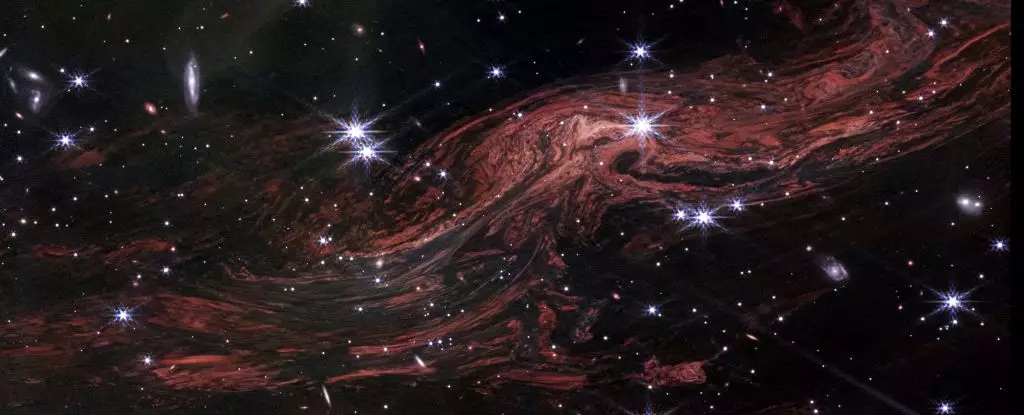The vast expanse of space is often perceived as a vacuum, a barren realm where stars glitter but matter is sparse. However, recent observations from the James Webb Space Telescope (JWST) have illuminated the intricate nature of the interstellar medium with unparalleled clarity. The findings pertaining to the remnants of the Cassiopeia A supernova, an explosive demise of a star observed from Earth in the late 17th century, unveil a world teeming with life-like complexity. Through cutting-edge imaging, astronomers have begun to decipher the enigmatic patterns and textures of dust and gas that fill this cosmic canvas.
For centuries, understanding the interstellar medium has proved challenging due to its subtle and faint luminance. Traditional telescopes often overlooked the delicate details that have now been captured with stunning precision by JWST. The telescope’s ability to detect infrared light has allowed scientists to explore wavelengths that were previously elusive, leading to a more profound comprehension of the interstellar material’s structure.
One of the most captivating phenomena captured in the JWST’s latest images is that of light echoes. A light echo occurs when a burst of luminosity—like that from the Cassiopeia A explosion—traverses through a medium and interacts with cosmic debris. Depending on the density and composition of the dust, the light reverberates in a fashion reminiscent of an acoustic echo, creating a mesmerizing visual of reflective glows. This mechanism not only adds layers of beauty to our understanding of the cosmos but serves a significant purpose in mapping and examining spatial structures.
The JWST has provided a transformative perspective of a specific wisp of dust identified as a light echo. Previously cataloged by NASA’s Spitzer Space Telescope, the detailed resolution of JWST has revealed structural intricacies analogous to an “onion-like” layering with knots and striations mimicking tree rings. These observations not only affirm the existence of these “light echo” formations but also suggest a deeper complexity within the interstellar medium that requires attention.
Astronomers are particularly astounded by the discovery of a three-dimensional structure in the spacing and arrangement of cosmic dust. Research indicates that this material exists in layers punctuated with whorls, resulting in a breathtaking visual display, reminiscent of wood grain patterns. The ability to observe these structures down to scales of about 400 astronomical units allows scientists to glean insights into how magnetic field lines may influence the formation and sustainability of the interstellar medium.
This newfound capability to analyze the interstellar medium opens a door to studying magnetized turbulence in space. As light echoes reveal intricate details, they help elucidate the flow of energy and the interaction of particles within the medium. Similar to how a medical CT scan slices through the human body to reveal internal structures, JWST allows astronomers to “slice” through the cosmos, providing snapshots that usher in a new era of cosmic research.
The implications of these findings are far-reaching. The JWST’s capability to uncover the intricacies of the interstellar medium not only enhances our understanding of the environment surrounding celestial bodies but also contributes to broader cosmic narratives. The ability to visualize dynamic changes within these structures—and at such a rapid timescale—encourages scientists to postulate about the processes governing star formation and the lifecycle of matter in space.
Moreover, the rapidly changing imagery captured by JWST within just weeks offers a glimpse into the time-sensitive nature of cosmic phenomena. Astronomers can now observe real-time events that shape the interstellar medium, shedding light on the evolutionary path of these galactic structures.
As researchers delve deeper into these groundbreaking observations, we can expect an influx of new studies and findings that will redefine our comprehension of the universe. The intricate interplay of light, dust, and magnetic fields in the context of the interstellar medium requires a collaborative effort in analysis and interpretation among astronomers worldwide.
The recent presentations to the American Astronomical Society highlight the growing excitement among scientists who now have access to unprecedented data. As they share their observations and research methodologies, a collaborative discourse emerges that holds the potential to unlock further mysteries of the universe.
The detailed studies of the Cassiopeia A remnants and surrounding interstellar dust signify a monumental leap in our understanding of cosmic structures. Thanks to the JWST’s technological prowess, the age-old enigma of the interstellar medium is gradually unraveling, paving the way for new dimensions of exploration in the realm of astronomy.

